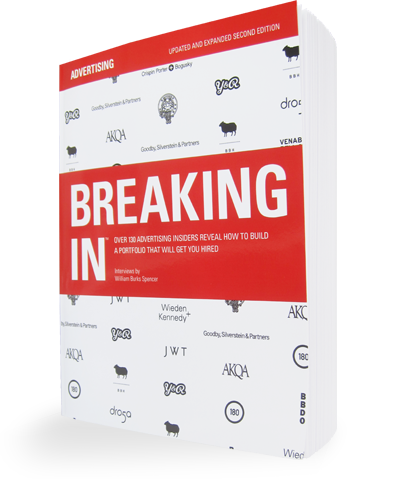Check out some great work from Kim Papworth.
WS: Do you like to see finished work or do you like to see sketches or do you care?
KP: I suppose I would start by saying I don’t particularly care. I’m looking for all those other things. However, I’ve learnt through…especially when you’re working on Pan-European pieces of work—the word “texture” is very important. Because things can get lost in translation and quite often having too much language is a nightmare so you’re better off keeping things very simple and creating strong textures that make people feel things. And some understanding of, again, that ability to show different tones is important, I think. So years ago, yes, you could go around with just little drawings in your book and it didn’t matter how bad or good they were. I think it just shows a level of understanding if you have got some stuff. But I wouldn’t say that I want a book where everything is finished to a very high standard. I’m quite happy to see some campaigns that are very sketchy and loose and maybe just a couple that are finished up or even one that’s finished up. I think I’d rather have that. Because sometimes, you know, books should be “working books.” And if something’s too finished up, it’s like, well, what you’re telling me is that that’s the finished thing. Whereas if it’s in a sketchy stage, it feels a bit more malleable and I think people talk about it in the more creative way. Because if it’s too finished, it’s like, “Well, yes, I do like that one,” “Well no, I don’t like that one.” Whereas if it’s a bit loose you go, “Oh, that’s interesting! Have you thought about this?” You know, you have a different conversation.
WS: How do you feel about long copy in a student book? Is it important?
KP: That’s a difficult question. The hard thing is this: creative directors or the people who are in position to actually give you a job, the conundrum is, they will probably only have, if you’re lucky, three minutes to look at your book. You have to realize that: that they are not sitting around all day going, “Oh, I’ve got an area in my diary today to look at books.” I looked at some books today, that is the first time in about two months and I’ve had half an hour to look at five books. Now, what’s difficult about that is I know I’ve got to get through five books in half an hour. And that means that you have to go at a certain pace, and that certain pace isn’t conducive to long copy, and that’s my concern. And, in a funny way, that’s why a lot of people will encourage students to keep things shorter and simpler, because that’s the nature of how these things work. I mean maybe, if you’ve got a bit of long copy that you’re particularly proud of, you need to think of an entertaining way of getting a creative director to read it. And don’t do it all the time, just do it once and think of an idea that goes, “I know you’re busy, but please take a couple of minutes to read this,” you know, and do it that way.
WS: So if it’s there and you don’t have time to read it then is that okay?
KP: Well, it’s okay but I won’t read it. That’s the problem. I don’t think there was any long copy today but if there had been long copy in there, I probably would have gone, “No, I haven’t got time to read it.
WS: And so that ends up just being a question mark for you because you don’t know if it’s good or bad?
KP: Yeah.
WS: What do you think about putting “non-ads” in the book or having a separate book of just other creative stuff?
KP: That’s fantastic. I think it’s really important. It’s something that Tony and I have always…if people come in and we see people with a book which we don’t do so much of now but we used to do a lot of it. We want to spend half the time talking to people about what they do outside of their books, and if they’ve got evidence then that’s even better. Because, I think, especially the way that media is going, I think the broader your thinking is, the better chance you’ve got of your ideas happening, and if they’re not right here, well you’ll be able to get them to work somewhere else. So I think it’s massively important. I mean, I’m disappointed now if I just see a book and it hasn’t got anything else in it.
[ … ]

Comments are closed.